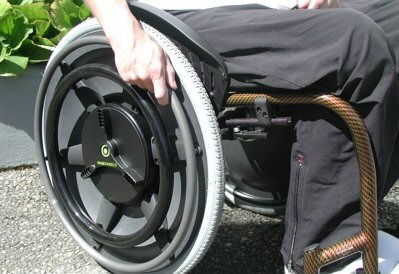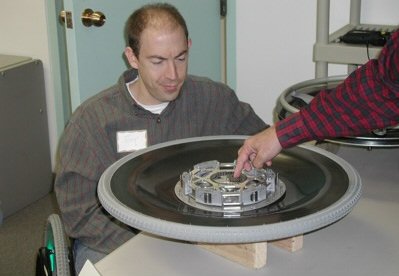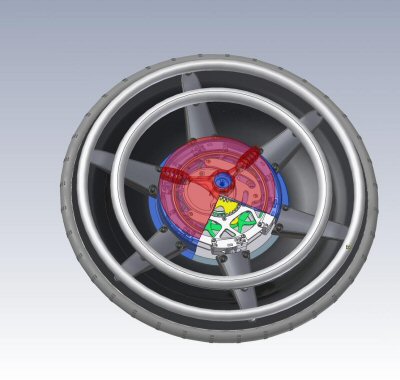Latest News
August 29, 2007
By Sara Ferris
Manual wheelchairs were first used in the United States around the time of the Civil War, and their design hasn’t changed much since then. Even with new lightweight materials that reduce the weight of wheelchairs, users still often suffer from shoulder pain and find it tough going on inclines and uneven terrain.
Gearing Up
Magic Wheels (Seattle, WA) had the idea to add a second gear, much like the gears on a bicycle. MAGICWHEELS feature a two-speed geared drive that reduces the effort needed to negotiate slopes and rugged surfaces. The quick-release wheels can be attached to existing wheelchairs.
 |
| MAGICWHEELS provides two gears to make it easier for users to handle inclines and rough surfaces. |
The two gears have ratios of 1:1 and 2:1. The wheelchair user simply flips a switch to change gears. Currently, only two gears are feasible because they shift on one plane perpendicular to the axle. Bicycles can have many gears because the gears are positioned along the axle. Magic Wheels does offer a wheel with a dual handrim configuration (a standard 21-inch rim and a 16-inch rim), which in conjunction with the two gears effectively provide four different speeds.
 |
| The gear mechanism is incorporated into the wheel itself. |
Besides the climbing benefit provided by the gear mechanism, Magic Wheels also features a hill-holding feature that keeps the chair from rolling backward on hills. Users can override this—to turn around, for example—by moving the wheel’s push rim backward. A pushrim-operated assisted braking feature reduces the effort needed to slow the wheelchair when doing downhill.
The strain of propelling a wheelchair can cause severe and chronic shoulder pain. Close to 80% of manual wheelchair users report shoulder pain. A University of Maryland study indicates that use of the Magic Wheels chair may reduce shoulder pain in long-term wheelchair users. Another advantage is that the gear system is purely mechanical, with no batteries that can run down and strand the user. Suggested retail price for a set of MAGICWHEELS is $4,995.
Digital Prototyping
The company used Autodesk’s Inventor software in developing the Magic Wheels product, which evolved over a nine-year period. Autodesk honored the company with its Inventor of the Month award in August 2007.
 |
| Magic Wheels designers use Autodesk Inventor for product design. |
“There has never been a more exciting time to be an inventor than now,” said Robert “Buzz” Kross, senior vice president of Autodesk Manufacturing Solutions. “Companies like Magic Wheels are using digital prototyping to refine the invention process, leveraging software that is as groundbreaking as their ideas.”
Innovation History
Magic Wheels was co-founded in 1996 by Steve Meginniss, who also invented or developed the Sonicare toothbrush, the Clarisonic skin care system, and the Quinton Quik-Prep electrodes used in stress testing. The company has received more than $2.9 million in funding, including $1.65 million from the NIH and $114,000 from the Washington Technology Center, which has funded strength, endurance and environmental testing at the University of Washington’s Materials Science Lab.
Sources: Press materials received from the company and additional information gleaned from the company’s website.
Subscribe to our FREE magazine, FREE email newsletters or both!
Latest News
About the Author
DE’s editors contribute news and new product announcements to Digital Engineering.
Press releases may be sent to them via [email protected].






